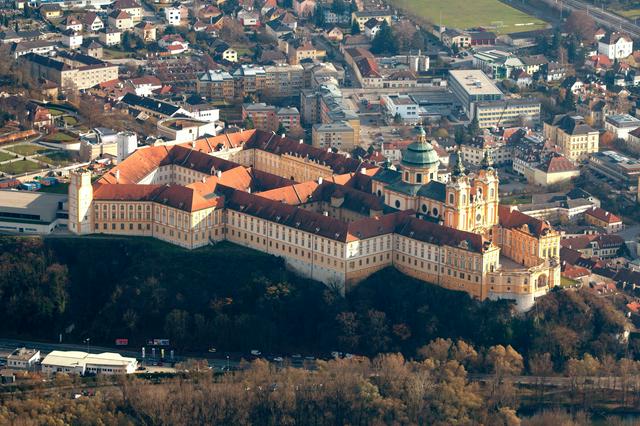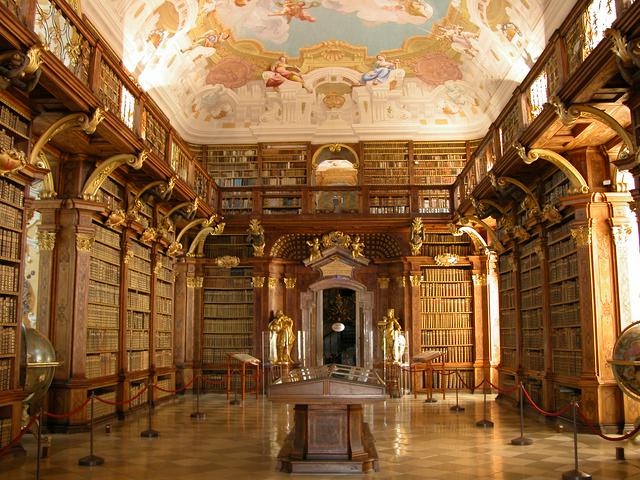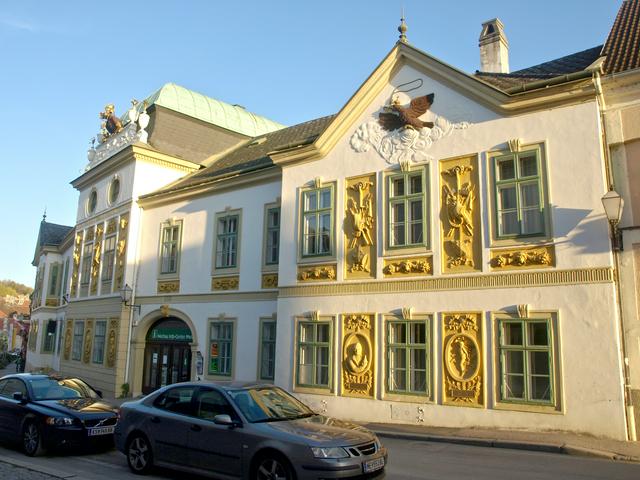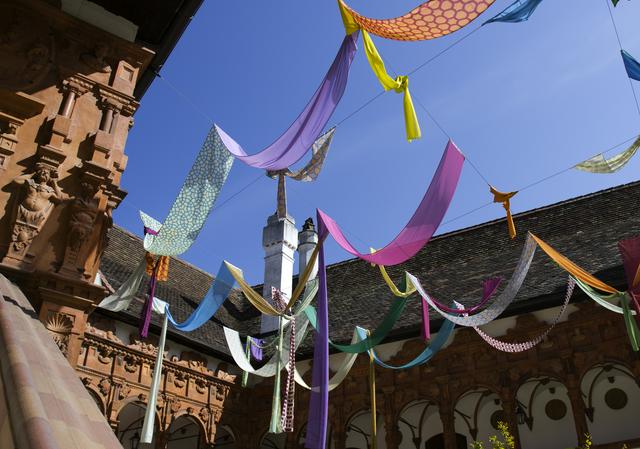Melk is a small riverside town (pop. ~5,000) on south bank of the Danube River in the Wachau Valley of Lower Austria. Melk marks the western terminus of the Wachau (86km west of Vienna) and lies upstream (40km west) from Krems.
- Stadtgemeinde Melk Tourismusbüro, Linzer Straße 5 (temporary location; original site damaged during flooding, +43 2752-511 60. Apr-Oct. Free town map with a self-guided walking tour, a list of Melk hotels and rooms, latest info on nearby castles, bike rentals, and bike rides along the river.
Stadtgemeinde Melk Tourismusbüro, Linzer Straße 5 (temporary location; original site damaged during flooding, +43 2752-511 60. Apr-Oct. Free town map with a self-guided walking tour, a list of Melk hotels and rooms, latest info on nearby castles, bike rentals, and bike rides along the river.




- Melk Benedictine Abbey, Abt-Berthold-Dietmayr-Straße 1 (ticket booth on the south side, entrance at the east, +43 2752-555-232. May-Sep daily 09:00-17:30 (last entrance at 17:00); Mar-Apr, Oct daily 09:00-16:30 (last entrance at 16:00); Nov-Mar: guided tours only at 11:00, 14:00, (German and English). The must-see in Melk. The abbey is built on a bluff overlooking the Danube River to the northwest and the town center to the south. Most of the design of the present abbey (a reconstruction started in 1702) was by the architect Jakob Prandtauer. The 200m-long Kaisergang (Imperial Corridor and Abbey Museum) is decorated with portraits of Austrian rulers. The Marmorsaal (Marble Hall) contains pilasters coated in red marble; a richly painted allegorical picture on the ceiling is the work of Paul Troger. The Bibliothek (Library), rising two floors, again with a Troger ceiling, contains some 80,000 volumes. The Stiftskirche (Abbey Church), with its 200-ft dome and symmetrical twin towers, dominates the abbey complex and emphasizes its sacred purpose. Damaged by fire in 1947, the church is now almost completely restored, even to the gold-bullion gilding of statues and altars. With/without guided tour: €11/13 (adults), €6/8 (concessions).
- Abbey Park and Baroque Garden Pavilion. May-Oct daily 09:00-18:00. Originally designed as a Baroque park in 1750, and replanted in 1822 as an English garden. €4 (adults), €3 (students), €1 (children 6-16); free with abbey admission.
- Stadtmuseum Melk, Linzer Straße 3-5, +43 2752 52307-112. Open only for special exhibits: Th-F 09:30-13:00, Sa-Su 15:00-19:00. Built in 1792 by the Viennese architect Franz Wipplinger, the building now houses a collection of prehistoric artifacts from the region, as well as a photographic archive and library. Special exhibits change annually.
- Town Hall, Rathaus Platz 11 (in the center of town. Built in 1575.
- Haus am Stein, Kremser Straße 2. Built in the 15th century, this is the oldest building in Melk. The building is a private residence but can be appreciated from the outside.
- Accordion Museum, Sterngasse 19, +43 2752 514 89, +43 664 431 70 25. Summer: T-Su 10:00-18:00. The accordion was invented in Vienna in 1829, and since then became popular around the world. This private museum has 250 accordions, including some very rare and eccentric pieces, with the oldest dating from 1860. Free, but donations appreciated.
- KZ-Gedenkstätte Melk, Schießstattweg 8, +43 2752 51 888. May-Jun: T-Su 10:00-14:00 and by appt.. From April 1944 until liberation in April 1945 this site was a concentration camp, operated as a branch of the main camp in Mauthausen. Approximately 5,000 Jews lost their lives here. The former crematorium has been preserved as a memorial.
- Schallaburg Castle, Schallaburg 1 (5km south of Melk, +43 2754 6317-0. Apr-Oct M-F 09:00-17:00, Sa Su and holidays 09:00-18:00. A well-preserved German Renaissance castle, on a site occupied since the Roman occupation; the foundation dates to the Romanesque period. Special architectural features include the courtyard with terracotta figures and the Renaissance garden. The building is now a museum with specially-themed, annually rotating exhibits. €10 (adults), €9 (concessions), €3.50 (children).
- Gugler Forum Melk, gugler print & media, Auf der Schön 2, Pielach, +43 2752 50050 0. M-Th 07:30-17:30, F 07:30-15:00. This graphic design agency hosts special solo artist exhibits three times a year from the contemporary Austrian art world. Artists are selected by an independent jury. A restaurant and café are onsite. Free.
Melk Benedictine Abbey, Abt-Berthold-Dietmayr-Straße 1 (ticket booth on the south side, entrance at the east, +43 2752-555-232. May-Sep daily 09:00-17:30 (last entrance at 17:00); Mar-Apr, Oct daily 09:00-16:30 (last entrance at 16:00); Nov-Mar: guided tours only at 11:00, 14:00, (German and English). The must-see in Melk. The abbey is built on a bluff overlooking the Danube River to the northwest and the town center to the south. Most of the design of the present abbey (a reconstruction started in 1702) was by the architect Jakob Prandtauer. The 200m-long Kaisergang (Imperial Corridor and Abbey Museum) is decorated with portraits of Austrian rulers. The Marmorsaal (Marble Hall) contains pilasters coated in red marble; a richly painted allegorical picture on the ceiling is the work of Paul Troger. The Bibliothek (Library), rising two floors, again with a Troger ceiling, contains some 80,000 volumes. The Stiftskirche (Abbey Church), with its 200-ft dome and symmetrical twin towers, dominates the abbey complex and emphasizes its sacred purpose. Damaged by fire in 1947, the church is now almost completely restored, even to the gold-bullion gilding of statues and altars. With/without guided tour: €11/13 (adults), €6/8 (concessions).
- Abbey Park and Baroque Garden Pavilion. May-Oct daily 09:00-18:00. Originally designed as a Baroque park in 1750, and replanted in 1822 as an English garden. €4 (adults), €3 (students), €1 (children 6-16); free with abbey admission.
Melk Benedictine Abbey, Abt-Berthold-Dietmayr-Straße 1 (ticket booth on the south side, entrance at the east, +43 2752-555-232. May-Sep daily 09:00-17:30 (last entrance at 17:00); Mar-Apr, Oct daily 09:00-16:30 (last entrance at 16:00); Nov-Mar: guided tours only at 11:00, 14:00, (German and English). The must-see in Melk. The abbey is built on a bluff overlooking the Danube River to the northwest and the town center to the south. Most of the design of the present abbey (a reconstruction started in 1702) was by the architect Jakob Prandtauer. The 200m-long Kaisergang (Imperial Corridor and Abbey Museum) is decorated with portraits of Austrian rulers. The Marmorsaal (Marble Hall) contains pilasters coated in red marble; a richly painted allegorical picture on the ceiling is the work of Paul Troger. The Bibliothek (Library), rising two floors, again with a Troger ceiling, contains some 80,000 volumes. The Stiftskirche (Abbey Church), with its 200-ft dome and symmetrical twin towers, dominates the abbey complex and emphasizes its sacred purpose. Damaged by fire in 1947, the church is now almost completely restored, even to the gold-bullion gilding of statues and altars. With/without guided tour: €11/13 (adults), €6/8 (concessions).
- Abbey Park and Baroque Garden Pavilion. May-Oct daily 09:00-18:00. Originally designed as a Baroque park in 1750, and replanted in 1822 as an English garden. €4 (adults), €3 (students), €1 (children 6-16); free with abbey admission.
Stadtmuseum Melk, Linzer Straße 3-5, +43 2752 52307-112. Open only for special exhibits: Th-F 09:30-13:00, Sa-Su 15:00-19:00. Built in 1792 by the Viennese architect Franz Wipplinger, the building now houses a collection of prehistoric artifacts from the region, as well as a photographic archive and library. Special exhibits change annually.
Town Hall, Rathaus Platz 11 (in the center of town. Built in 1575.
Haus am Stein, Kremser Straße 2. Built in the 15th century, this is the oldest building in Melk. The building is a private residence but can be appreciated from the outside.
Accordion Museum, Sterngasse 19, +43 2752 514 89, +43 664 431 70 25. Summer: T-Su 10:00-18:00. The accordion was invented in Vienna in 1829, and since then became popular around the world. This private museum has 250 accordions, including some very rare and eccentric pieces, with the oldest dating from 1860. Free, but donations appreciated.
KZ-Gedenkstätte Melk, Schießstattweg 8, +43 2752 51 888. May-Jun: T-Su 10:00-14:00 and by appt.. From April 1944 until liberation in April 1945 this site was a concentration camp, operated as a branch of the main camp in Mauthausen. Approximately 5,000 Jews lost their lives here. The former crematorium has been preserved as a memorial.
Schallaburg Castle, Schallaburg 1 (5km south of Melk, +43 2754 6317-0. Apr-Oct M-F 09:00-17:00, Sa Su and holidays 09:00-18:00. A well-preserved German Renaissance castle, on a site occupied since the Roman occupation; the foundation dates to the Romanesque period. Special architectural features include the courtyard with terracotta figures and the Renaissance garden. The building is now a museum with specially-themed, annually rotating exhibits. €10 (adults), €9 (concessions), €3.50 (children).
Gugler Forum Melk, gugler print & media, Auf der Schön 2, Pielach, +43 2752 50050 0. M-Th 07:30-17:30, F 07:30-15:00. This graphic design agency hosts special solo artist exhibits three times a year from the contemporary Austrian art world. Artists are selected by an independent jury. A restaurant and café are onsite. Free.
- Wachberg. This 285m hill is on the eastern outskirts of Melk, and has great views of the Abbey and the river.
Wachberg. This 285m hill is on the eastern outskirts of Melk, and has great views of the Abbey and the river.
- Hotel Restaurant zur Post, Linzer Straße 1, +43 2752 523 45. Daily 11:30-14:30, 18:00-21:30.
- Hotel Restaurant Stadt Melk, Hauptplatz 1, +43 2752 52475. W-Su 11:30-14:30 18:00-20:30. A well-established restaurant. Reservations can be made online.
- Stiftrestaurant Melk, Abt-Berthold-Dietmayrstrasse 3 (near the entrance to the Abbey, +43 2752 52 555. Apr-Oct daily 09:00-18:00, Nov-Mar daily 10:00-15:30; closed 23-25 Dec. Operated by the Melk Abbey. Main courses €8-€13.
Hotel Restaurant zur Post, Linzer Straße 1, +43 2752 523 45. Daily 11:30-14:30, 18:00-21:30.
Hotel Restaurant Stadt Melk, Hauptplatz 1, +43 2752 52475. W-Su 11:30-14:30 18:00-20:30. A well-established restaurant. Reservations can be made online.
Stiftrestaurant Melk, Abt-Berthold-Dietmayrstrasse 3 (near the entrance to the Abbey, +43 2752 52 555. Apr-Oct daily 09:00-18:00, Nov-Mar daily 10:00-15:30; closed 23-25 Dec. Operated by the Melk Abbey. Main courses €8-€13.
The following sights are all within a 20km radius of Melk.
- Maria Taferl Sanctuary, Maria Taferl 1 (20km W of Melk on the N side of the Danube, +43 7413 278. This unusual site has both a pre-Christian sacrificial stone and a Catholic sanctuary. According to legend, a carved Pietá was placed at an oak tree in thanksgiving for a miraculous healing; eventually the site was associated with miraculous sightings of the Virgin Mary. The oak tree was burned in 1755, and the current building dates from the Baroque period. The Celtic sacrificial stone (Opferstein) is located in front of the church; the stone balustrade surrounding it dates from the 18th century.
- Treasury of the Maria Taferl Sanctuary, +43 7413 278-27. Apr-Oct T-Su 10:30-16:30; by appt. Votive offerings, paintings, and liturgical vestments are on display, as well as the cope worn by the Empress Elisabeth with her wedding dress. €3 (adults), €1.50 (children).
- Artstetten Castle, Schlossplatz 1, Artstetten (W of Melk on the N side of the Danube, a short distance from Maria Taferl, +43 7413 8006-0. Apr-Oct daily 09:00-17:30, last admission at 17:00. Castle, museum, and final resting place of the Archduke Franz Ferdinand, whose assassination in Sarajevo in 1914 sparked WWI. Documents and artifacts from his life are on display, as well as his personal collections, with rotating exhibits. €8 (adults), €7.50 (seniors), €6 (concessions), €5 (children 6-15).
- Oskar Kokoschka Haus, Regensburger Straße 29, Pöchlarn (S side of the Danube, across from Maria Taferl, +43 2757 7656 (during opening hrs), +43 2757 2310 14 (other times). May-Oct daily 09:00-17:00. The Austrian painter was born in this house on 1 Mar 1886. The museum hosts annual summer exhibits with pieces from public and private collections, curated by the University of Applied Arts Vienna. €5 (adults), €3.50 (concessions).
- Pilgrimage Church of Maria Langegg, Maria Langegg 1, Maria Langegg (18 km northeast via the B33 alongside the Danube to Aggsbach-Dorf, then the L162 and L109 into the hills, +43 2753 210. This is an impressive Baroque church, with frescoes by Josef Adam Mölk (1714-1794).
- Explore the Wachau Valley between Melk and Krems (40 km downstream) by bike or river cruise. The valley is listed by UNESCO as a World Heritage Site.
Maria Taferl Sanctuary, Maria Taferl 1 (20km W of Melk on the N side of the Danube, +43 7413 278. This unusual site has both a pre-Christian sacrificial stone and a Catholic sanctuary. According to legend, a carved Pietá was placed at an oak tree in thanksgiving for a miraculous healing; eventually the site was associated with miraculous sightings of the Virgin Mary. The oak tree was burned in 1755, and the current building dates from the Baroque period. The Celtic sacrificial stone (Opferstein) is located in front of the church; the stone balustrade surrounding it dates from the 18th century.
- Treasury of the Maria Taferl Sanctuary, +43 7413 278-27. Apr-Oct T-Su 10:30-16:30; by appt. Votive offerings, paintings, and liturgical vestments are on display, as well as the cope worn by the Empress Elisabeth with her wedding dress. €3 (adults), €1.50 (children).
Maria Taferl Sanctuary, Maria Taferl 1 (20km W of Melk on the N side of the Danube, +43 7413 278. This unusual site has both a pre-Christian sacrificial stone and a Catholic sanctuary. According to legend, a carved Pietá was placed at an oak tree in thanksgiving for a miraculous healing; eventually the site was associated with miraculous sightings of the Virgin Mary. The oak tree was burned in 1755, and the current building dates from the Baroque period. The Celtic sacrificial stone (Opferstein) is located in front of the church; the stone balustrade surrounding it dates from the 18th century.
- Treasury of the Maria Taferl Sanctuary, +43 7413 278-27. Apr-Oct T-Su 10:30-16:30; by appt. Votive offerings, paintings, and liturgical vestments are on display, as well as the cope worn by the Empress Elisabeth with her wedding dress. €3 (adults), €1.50 (children).
Artstetten Castle, Schlossplatz 1, Artstetten (W of Melk on the N side of the Danube, a short distance from Maria Taferl, +43 7413 8006-0. Apr-Oct daily 09:00-17:30, last admission at 17:00. Castle, museum, and final resting place of the Archduke Franz Ferdinand, whose assassination in Sarajevo in 1914 sparked WWI. Documents and artifacts from his life are on display, as well as his personal collections, with rotating exhibits. €8 (adults), €7.50 (seniors), €6 (concessions), €5 (children 6-15).
Oskar Kokoschka Haus, Regensburger Straße 29, Pöchlarn (S side of the Danube, across from Maria Taferl, +43 2757 7656 (during opening hrs), +43 2757 2310 14 (other times). May-Oct daily 09:00-17:00. The Austrian painter was born in this house on 1 Mar 1886. The museum hosts annual summer exhibits with pieces from public and private collections, curated by the University of Applied Arts Vienna. €5 (adults), €3.50 (concessions).
Pilgrimage Church of Maria Langegg, Maria Langegg 1, Maria Langegg (18 km northeast via the B33 alongside the Danube to Aggsbach-Dorf, then the L162 and L109 into the hills, +43 2753 210. This is an impressive Baroque church, with frescoes by Josef Adam Mölk (1714-1794).
